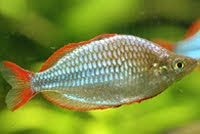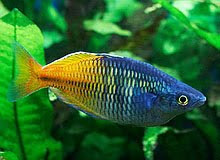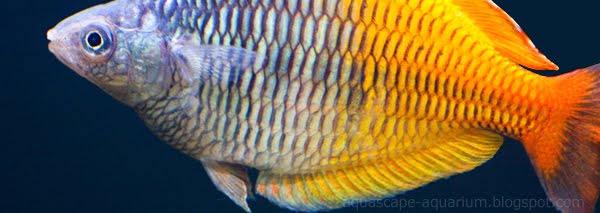Keeping Dwarf Neon Rainbowfish
Friday, June 10, 2011
Other
Dwarf Neon Rainbow,
Freshwater Fish,
Melanotaenia Praecox,
Rainbowfishes
 The Melanotaenia praecox is an active, beautiful and hardy fish. The Praecox Rainbow, otherwise known as the Dwarf Neon Rainbow, is a peaceful schooling fish. Such as Boesemani rainbowfish, Melanotaenia praecox also known for their characteristic large eyes, black or silver band that runs through the middle scale rows, deeply forked mouths, and two dorsal fins. Males are smaller and narrower and have more of the silvery bluish tinge in their bodies and more orange in their fins. The females are larger and have more yellow in their fins.
The Melanotaenia praecox is an active, beautiful and hardy fish. The Praecox Rainbow, otherwise known as the Dwarf Neon Rainbow, is a peaceful schooling fish. Such as Boesemani rainbowfish, Melanotaenia praecox also known for their characteristic large eyes, black or silver band that runs through the middle scale rows, deeply forked mouths, and two dorsal fins. Males are smaller and narrower and have more of the silvery bluish tinge in their bodies and more orange in their fins. The females are larger and have more yellow in their fins.Keeping Dwarf Neon Rainbowfish in a big school at least groups of five to seven is the best way but this also means larger tanks are more suitable for this fish - 100 liters and above. An aquascape aquarium with plenty of free swimming places available will provide a good environment for Melanotaenia praecox. A dark colored gravel substrate may intensify the Praecox Rainbow's colors. This is an active, beautiful and hardy fish. Regularly do a 20% water change without even adding anti-chlorine and they seem to cope very well with it.


 The Praecox Rainbow is a freshwater fish for planted aquarium and an egg layer that spawns over a moss substrate. At a temperature of around 75°F, the fry will hatch after six or seven days. Adults should be removed from the fry after hatching. Fry should be fed small pieces of live foods such as brine shrimp.
The Praecox Rainbow is a freshwater fish for planted aquarium and an egg layer that spawns over a moss substrate. At a temperature of around 75°F, the fry will hatch after six or seven days. Adults should be removed from the fry after hatching. Fry should be fed small pieces of live foods such as brine shrimp.

 Although Praecox Rainbows have large mouths, their throats tend to be narrow. With this in mind, foods should not be too large. The Praecox Rainbow should be fed an omnivorous diet of prepared flakes, frozen, and live foods.
Although Praecox Rainbows have large mouths, their throats tend to be narrow. With this in mind, foods should not be too large. The Praecox Rainbow should be fed an omnivorous diet of prepared flakes, frozen, and live foods.They seem happy in my very hard water and at pH 8.0, and they enjoy flake, bloodworms, and brine shrimp. I recommend praecox rainbows to anyone with a smaller sized peaceful community tank, because they are gorgeous, hardy, not as large as other rainbowfish species, and they don't have any special requirements. A good freshwater tropical fish for beginners!
















